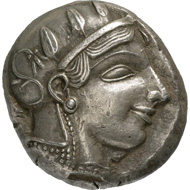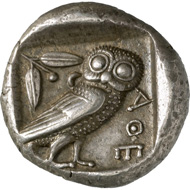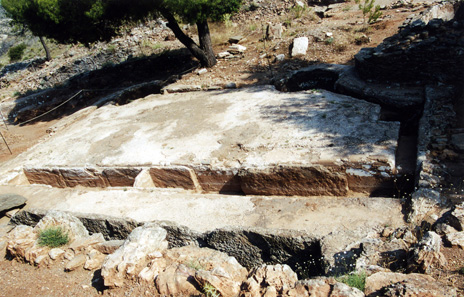with the kind permission of the MoneyMuseum, Zurich.
Why is it that for centuries – or, rather, thousands of years – the head has served as the motif for the side of a coin? And why has this changed in the last 200 years? Ursula Kampmann poses these questions in her book ‘MenschenGesichter,’ from which the texts for our new series are taken.
Athens. Tetradrachm, around 450 BC. Head of the goddess Athena with helmet, facing right, on the helmet are a palmette and three ornamental leaves of the olive tree. Reverse, sitting owl, facing right, a branch of the olive tree behind it with leaves and fruit, as well as a crescent moon. © MoneyMuseum, Zurich.
A widely known ancient myth tells how Athena became the Protectress of Athens: Long ago, the Gods Poseidon and Athena fought over who should have dominion over Attica. They decided, in best Greek tradition, that they would have a contest to settle who would be allowed to protect the people living there and, in return, receive offerings from them. Whoever could present the better gift to the Athenians would become the protective deity of Attica. Poseidon thrust his trident into the rocky ground and a saltwater stream gushed forth, while Athena produced the gift of the olive tree, one of the most important agricultural crops of all time. From its fruits, oil was pressed with which the Greeks cooked their food, cared for their bodies and illuminated the night. And so, the decision was easy: Athena became the most important protectress of Athens. This status also brought – at least according to ancient notions – benefits to the Goddess, since Athens was a rich city with the resources to honour its deity through magnificent votive offerings, opulent sacrificial offerings and great processions. The relationship between city and deity at the time came to be understood as a sort of contract, in which the deity was only obligated to provide her help as long she received her due reverence from her entrusted citizens.
And so, Athena is depicted on this coin as the Goddess who, through her gift, had done a great service to the Athenians in the past and would continue to do so in the future. Her helmet is adorned with the leaves of the tree that she bestowed upon them, and on the reverse, above the owl, the sacred animal of Athena, we find a small olive branch. Depicting these benefactions of the Goddess was important, as it was through these that Athena, who was worshipped in most Greek cities, became characterized specifically as the deity of Athens.
Washing bays in the silver mines of Laurion (Argileza). Photo: Ursula Kampmann.
Whether due to the help of Athena or the silver that was found in the Attic mines at Laurion, or the uncompromising power politics of Athenian democracy – the owls, as the city’s coinage was referred to in ancient times, were the most important trading currency throughout the entire Mediterranean at the end of the 5th and beginning of the 4th centuries BC. And prior to the self-destructive conflict with Sparta in the Peloponnesian War, Athens became so wealthy that a well known saying arose that is still known today: ‘Taking owls to Athens’ – the English translation of ‘carrying coals to Newcastle’ conveys a similar sentiment – that of doing something that, given the circumstances, would be redundant.
You can find more about the mines of Laurion here.
The next article is devoted to the Arethusa in Sicily.
All sections of the series can be found here.
The book ‘MenschenGesichter’ is available in printed form from the Conzett Verlag website where you can find it as an ebook too. It soon will be translated to English.






